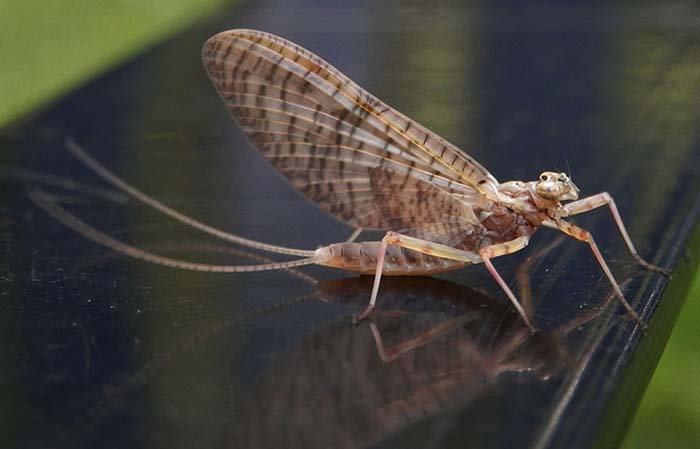I bug your pardon – Mayfly life cycle

Mayfly (Ephemeroptera) in Guelph, Ontario, Canada. Photo credit Ryan Hodnett – a commons image.
Know this bug and all its metamorphosis’. Learn to tie this winged insect
Ephemeroptera. Pay attention to stage/hook sizes, you’ll be rewarded
By Skip Clement
[dropcap]T[/dropcap]hey’re the oldest of the winged insects and were around millions of year ago along with tarpon. They remain the primitive species of yore and carry on their business 12 months of the year, and that leaves them with no equal in sheer numbers. They are found in most clean water streams, rivers, and lakes of the world. Everything that swims feeds on them, and every trout throughout their life feeds on them because they are a reliable source of food 24/7.
Mayflies go through incomplete metamorphosis, going from egg to nymph to adult, and lacking an intermediate pupal stage. The mayfly nymph, in essence, is a larva which, unlike a typical insect larva, already resembles an adult’s form. (Complete metamorphosis in insect world includes four stages: eggs, larva, pupa, and adult.) On the other hand, mayflies are unique as being the only insect to have two winged adult life stages – the sexually immature – subimago and the reproductive, mature – imago.” — Frosty Fly
The life cycle of a mayfly begins with nymph
When the water gets warm enough, it creates air gases under their exoskeleton initiating a buoyancy that forces them to the surface… which they resist. Since they do not breathe during that phase many will have died before they get to the surface because of exhaustion – unable to shed their shell. Others come out of their shell subsurface or on the surface. Both stages make them extremely vulnerable and targeted by trouts. Some species crawl to the shore to molt.
Mayfly Molting (Emerging): Emerger to Dun. They are not “drying” their wings
When the shell cracks open the wings are freed, and the adult mayfly gets released and is called a dun (subimago). Danger abounds in this stage because the metamorphosis is incomplete – they’re waiting for their wings to fill with fluid and veins to harden. Within hours or a few days, the sexually immature dun will transform again.

Nymph of the mayfly Cloeon dipterum, showing seven pairs of gills along the sides of the abdomen. Photo credit Thom Quinet – a commons image.
Mayfly Second Molt Dun to Spinner. Have a nice day
In this final transformation they do not eat or drink, their mouth is non-functional — they release a scent to attract mates. They only have reproductive organs. Adult spinners have short antennae and large eyes.
To get it on they fly in big swarms close to the water and mate in flight – it creates a “spinner fall”
After mating, the female would fly off to the vegetation to wait for eggs to fertilize. They would return to the water to descend to the surface of the water to lay eggs. Most drop the eggs while still in flight, from above the water, while others dip the back part of the abdomen to deposit them into the water. This process is exhausting. When they are finished, they fall to the water surface, and float motionless, with their wings, stretched out on the water and are now known as spent. Spinners usually die shortly after mating, generally within a couple of hours. These spinner falls usually happen in either dusk or dawn and is a great time to catch some trout rises. After mating, male spinners mostly fly off to the nearby shore where they would die. Most spent mayflies found on the water surface are females – and these insects should be imitated when tying your patterns, as males and females can differ in sizes and colors.
Deposited mayfly eggs drop to the bottom and stick to stones and vegetation, from where they would hatch into nymphs within either a few days to a couple of weeks, depending on the species. During the hatch, as mayflies mate in enormous swarms, all at the same time, for trout and birds that feed on them this comes as a feeding frenzy. For fly fisherman – a challenge in itself as getting a trout to bite into your mayfly imitation on a hook when so many other real insects are offered is no easy task. Mayfly hatching typically lasts a couple of hours and occurs in few days during spring or summer, but, there are a few species that hatch in the fall.” — Frosty Fly
Watch a mayfly life cycle

